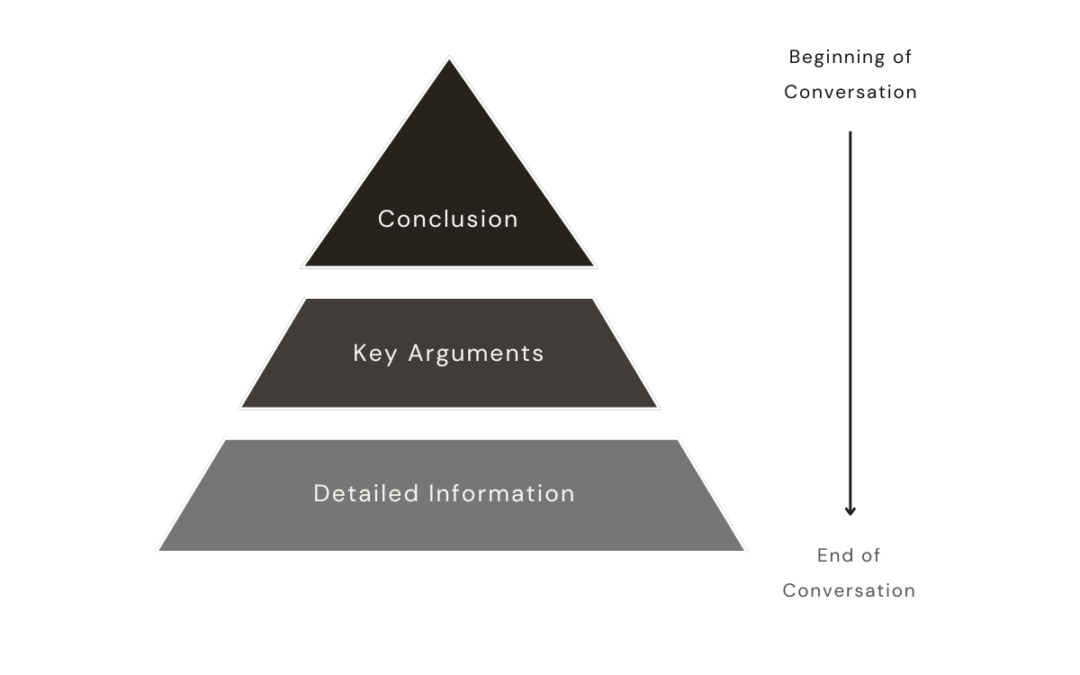Reading Time: 5 minutes
Key Points
- The Minto Pyramid is a structured communication method that employs a top-down structure, leading with the conclusion, followed by key points, and detailed information.
- This method is efficient, respecting the audience’s time and attention span, allowing for the immediate understanding of the main message with optional detailed exploration.
The Minto Pyramid: A Strategy for Clear and Efficient Communication
In the fast-paced world of business, effective communication is crucial. We are constantly inundated with information, making the need for concise, clear, and impactful communication more crucial than ever.
The Minto Pyramid Principle offers a structured approach to communication, ensuring your main message is delivered promptly and understood easily.
The Essence of the Minto Pyramid
The Minto Pyramid enhances the clarity and efficiency of your communication by employing a top-down structure to convey information in the following order:
1. The conclusion
2. Key arguments
3. Detailed information
It’s about delivering the ‘bottom line up front’ so that your audience grasps the main message without combing through a sea of details.
This method is particularly effective in the business environment where time is of the essence, and attention spans are short.
How the Minto Pyramid Works
1. Lead with the Conclusion: Starting your communication with the conclusion captures your audience’s attention and provides the main takeaway or message right from the beginning. It is contrary to traditional communication methods but is highly effective, especially in writing, for audiences with limited time or attention.
If you are reading this article, you may have noticed the key points section as the first bit of content, this is the Minto Pyramid at work.
This principle is known as BLUF – “bottom line up front”, originating from military communication strategies but is now extensively applied in business communication.
2. Follow with Key Arguments: Once the main message is out, it’s time to fortify it with key arguments or main points, providing a succinct summary of each point.
This part addresses the “why” behind your conclusion or recommendation, offering a rationale for the main message conveyed initially.
3. Support Points with Detailed Information: To lend credibility to your key points, offer detailed information, facts, evidence, numbers, or results that support them.
This step allows for an in-depth exploration of each point, catering to those in your audience who seek a deeper understanding or need more convincing. However, busy individuals might skip this part, focusing primarily on the conclusion and key points.
The Practical Application of the Minto Pyramid
Consider a scenario where a researcher wishes to share the results of a study, along with recommendations, with colleagues. Using the Minto Pyramid, the communication would begin with a clear recommendation, followed by key findings, and finally, detailed data, evidence, and results supporting those findings. This approach ensures that the audience receives the most critical information first, delving into the details only if they wish to.
Example:
- Conclusion: Implementing a new project management tool will increase our team’s productivity by 30%.
- Key Points:
- The current tool lacks advanced features needed for efficient project management.
- The proposed tool has superior reviews and ratings, indicating higher user satisfaction.
- Detailed Information: Data and evidence supporting the key points, such as user testimonials, feature comparison charts, and results from pilot testing.
Benefits and Impact
The Minto Pyramid’s beauty lies in its simplicity and effectiveness. By presenting the conclusion first, it respects the audience’s time and attention, allowing them to grasp the main idea quickly.
The supporting points and detailed information are there for those who seek a deeper understanding, but they are not a prerequisite to understanding the main message. This method is especially beneficial for busy professionals who prefer clear and concise communication.
Giving Your Audience Options
By leading with the conclusion, substantiating it with key points, and providing detailed support, you cater to the varied needs of your audience, ensuring your message is received, understood, and appreciated.
Final Thoughts:
Remember, in the world of information overload, being clear, concise, and to the point is not just appreciated—it’s a necessity. The next time you find yourself drafting a lengthy email or preparing for a presentation, consider the Minto Pyramid. Your audience will thank you.
Actionable Nudges and Inquiries:
Inquiries:
- Is my conclusion clear and concise? Ensure that the main message is understood easily without any ambiguity.
- Are my key points compelling and supportive of my conclusion? Evaluate if the key points provided are strong enough to substantiate the conclusion.
- Is the detailed information provided relevant and necessary? Assess the relevance and necessity of the detailed information, ensuring it adds value to the key points and conclusion.
Actionable Actions:
- Prioritize Your Message: Before drafting an email or preparing a presentation, clarify the main message or conclusion you want to convey.
- Identify Key Points: Once the main message is clear, outline the key points or arguments that support this message.
- Gather Detailed Information: Collect all the facts, data, and evidence that substantiate your key points.
Sources
“The Minto Pyramid Principle” by Barbara Minto
“BLUF: The Military Standard That Can Make Your Writing More Powerful” by Jan-Erik Asplund

